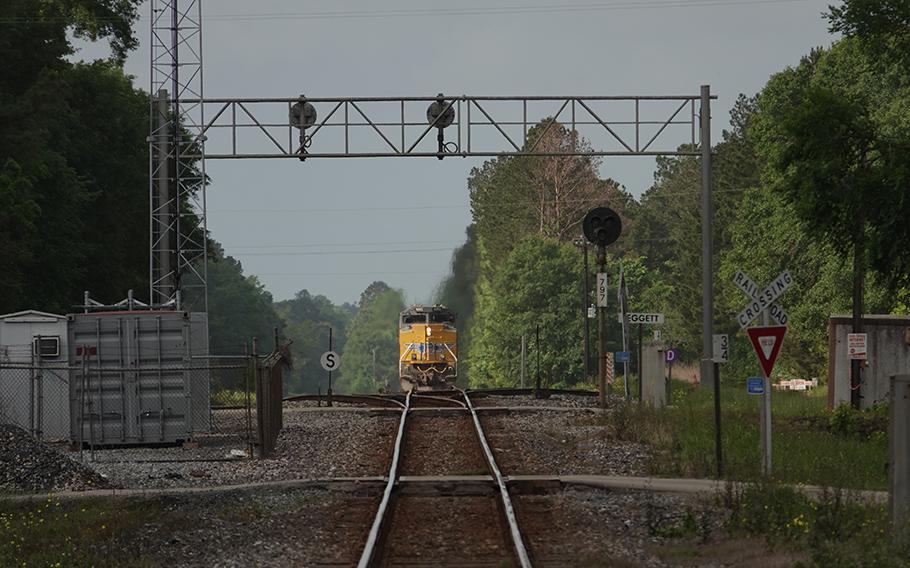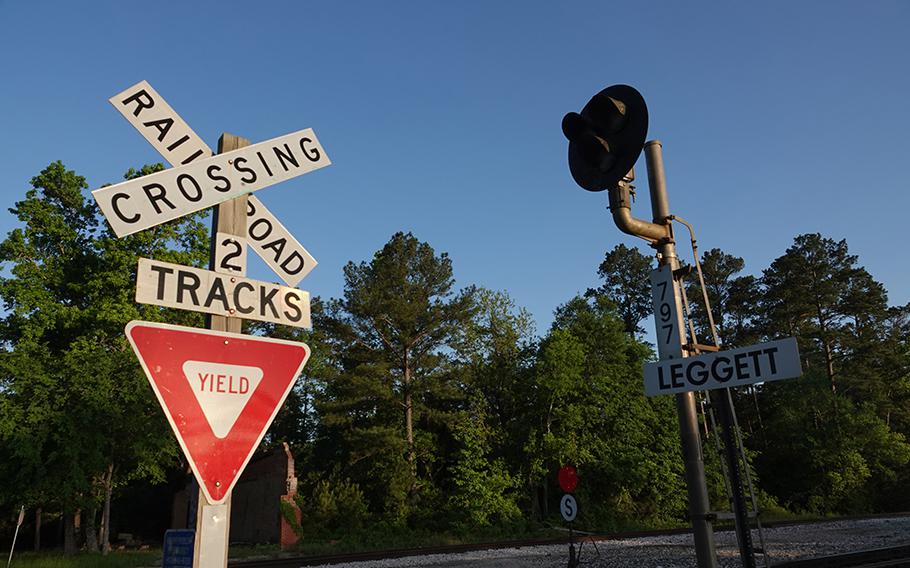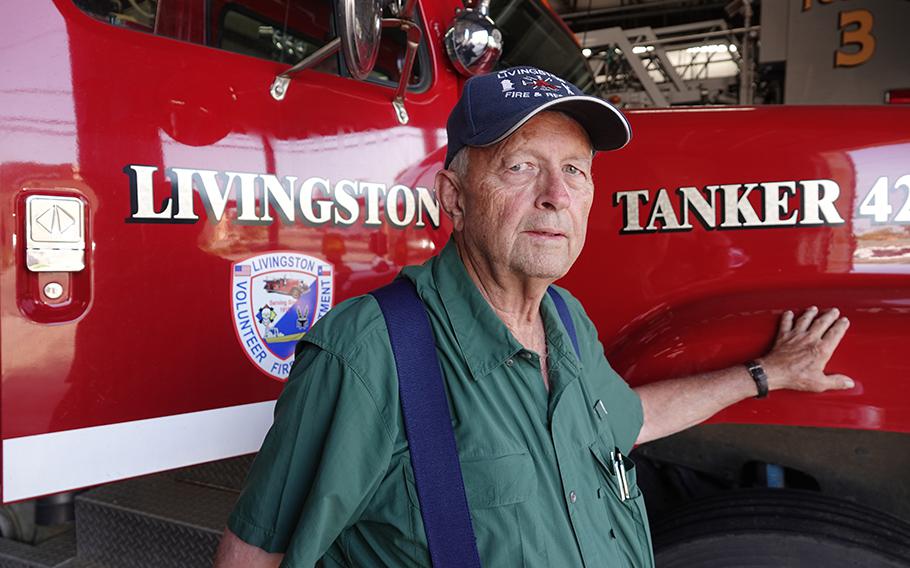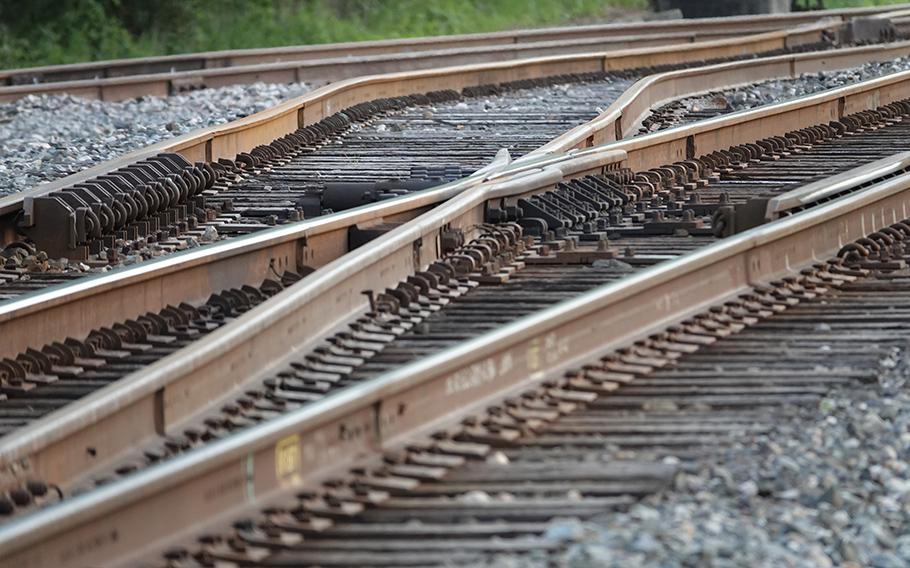U.S.
Miles-long trains are blocking first responders when every minute counts
The Washington Post May 26, 2023

A Union Pacific Railroad freight train recedes into the distance, heading south out of Leggett, Tex., on April 19, 2023. (Lee Powell/Washington Post)
LEGGETT, Tex. - A man suffered a stroke but a stopped train blocked paramedics from reaching him for over an hour. A senior in a nearby retirement community missed his oncologist appointment because another train obstructed that same intersection. A fire crew could not get to a house engulfed in flames until another train eventually cleared the crossing.
For decades, those living along Glover Road in Leggett, Tex. - a rural community with fewer than 150 residents some 80 miles from Houston - wrote letters, sent emails and called authorities pleading that trains stop blocking the neighborhood's sole point of entry and exit for hours. Some residents and a county judge sent letters addressed to the railroad company, warning of a "greater catastrophe," including a toxic train disaster.
"Should there be a derailment . . . we would be dead ducks, having no evacuating route," Pete Glover, the man whom the street is named after, wrote in a 1992 letter to the railway company. "If some home caught afire," he added. there'd be "no way for firetrucks to serve them."
To many in the community, their worst fears were realized in 2021, when baby K'Twon Franklin died. His mother, Monica Franklin, had found the three-month old unresponsive in her bed the morning of Sept. 30, and called 911.
Paramedics responded, but a Union Pacific train blocked their path on Glover Road, according to Franklin and a local police report. It took more than 30 minutes for them to carry K'Twon into an ambulance. Two days later, the baby died at a hospital in Houston. "Unfortunately, the delay has cost my child's life," Franklin, 34, told The Washington Post.
Over the last decade, rail corporations have been running more lengthy freight trains - some as long as three miles - partly to save fuel and labor costs. As they do, they are blocking rural and urban intersections, stoking anger and contributing to tragedies and calamities.
Much of the nation's focus has been on a long Norfolk Southern train that derailed in East Palestine, Ohio in February, sparking a toxic fireball and prompting state and federal investigations. But while Congress has shown some renewed concern about rail safety, there's been little focus on an everyday safety threat - long trains blocking first responders from getting to emergencies.
It is happening across the country. In Tennessee, a man died of a medical emergency after an ambulance crew was held up at a train crossing. In Oklahoma, a man perished from a heart attack after first responders were stuck behind a train at the only entrance to their street.
Since 2019, the Federal Railroad Administration (FRA) has operated a digital portal where citizens can report obstructions caused by trains. So far this year, there have been more than 1,400 reports of first responders blocked by trains. There have also been documented cases of frustrated pedestrians crawling under stopped trains, only to be injured or killed when the train starts moving.
In Texas, K'Twon's mother has filed a lawsuit against Union Pacific, claiming its routine blockage of the Glover Road intersection prevented paramedics from reaching her child, thereby causing his death. In response, the railway company has offered its sympathy and said it is working to resolve problems at intersections in Leggett and other communities.
"Our hearts go out to K'Twon's family on this tragic situation," the company said in a statement. "Union Pacific is in the early phases of litigation discovery, investigating the overall factual timeline, including whether the presence of a train had any impact on first responders' ability to revive K'Twon. We understand the impact blocked crossings have for community residents and work diligently to reduce the amount of time trains occupy the crossing."
Many residents of Leggett put little stock in such pledges.

The Glover Road rail crossing in Leggett, Tex., on April 19, 2023. (Lee Powell/Washington Post)
Schools superintendent Jana Lowe is one of several local leaders and residents who have been writing and calling Union Pacific for years, warning that obstructions at the Glover Road crossing - such as school buses delayed for hours - could lead to something more horrific.
"I fairly believe that this cost a child's life, that they weren't able to get there on time," she said. "It's heartbreaking. It could have been avoided."
In his 25 years as a locomotive engineer, Eddie Hall saw his trains grow longer and longer. He can recall when they were just over a mile in length. Before going on leave last winter, he was driving a 3-mile long Union Pacific train with as much 18,000 tons of mixed freight on his regular Tucson to El Paso route.
He's seen his line of freight cars disrupt traffic for hours in small and rural towns, he said adding that in Tucson, trains can block the downtown's four railroad crossings for as long as an hour.
"Whatever they block, they block," said Hall, who now leads the Brotherhood of Locomotive Engineers and Trainmen. "The carriers really don't take into consideration how long we sit on rail crossings."
Trains have mushroomed in length for a simple reason - they save money and generate profits for railway companies and their shareholders. Roughly two decades ago, activist investors started pressuring railway corporations to become more efficient, by reducing labor and fuel costs. So railroads adopted an operating model that cut crews and consolidated trains, known as "precision scheduled railroading." By using longer trains, rail companies are operating fewer shorter trains, increasing fuel efficiencies and decreasing costs and their carbon footprints, industry officials say.
It has paid off. BNSF Railway and Union Pacific, the two largest railroad corporations in the nation, have reported record earnings in recent years. U.S. railroads have paid out $196 billion on stock buybacks and dividends to shareholders since 2010.
Rail industry officials say the use of longer trains has also helped improve safety, and they point to an overall decline in derailments. But in the aftermath of the East Palestine spill, federal regulators have warned that long trains deserve closer review and can contribute to derailments.
About 1,000 trains derail annually nationwide, according to the FRA, including a spate this year.
Following the Ohio incident, a train derailed on the Swinomish Reservation in Anacortes, Wash. in mid-March, spilling diesel fuel. Also in March a train passing through Springfield, Ohio, went off its tracks - leading to a shelter in place - and a small town in Minnesota was evacuated after a train carrying ethanol derailed and caught fire.
A FRA advisory last month urged railroads to make sure that engineers are adequately trained to handle long sets of freight cars and that locomotives don't lose communication with devices at the end of trains that can help trigger the brakes in an emergency. Federal regulators also highlighted safety risks associated with blocked crossings, particularly how stopped trains can impede access to emergency services.
The FRA's recommendations stopped short of mandating trains size limits, which some labor unions and local communities have demanded. Members of Congress and state lawmakers in at least five states have proposed establishing length restrictions in the wake of the Feb. 3 Norfolk Southern derailment in Ohio. In that incident, federal investigators have said that an overheating wheel bearing led the 149-car train to derail. The train's length, approximately 1.8 miles long, has not been identified as a potential factor.
Union Pacific CEO Lance Fritz said in an earnings call last month that accident data doesn't show that long trains are riskier. He said that since 2019, train length is up by about 20 percent in his railroad's network, while mainline and siding derailments are down by 26 percent.
"There's zero corollary between train length and derailments," Fritz said.
Labor unions, however, say longer trains tend to require more maintenance because greater stress is placed on the equipment, and they cause greater conflicts in communities.
"When you have first responders trying to get from one side of the track to another, in a small town like that, you're putting the public safety at risk," Hall said.
Leggett, an hour north of Houston, is an unincorporated community surrounded by farms and cattle ranches, a part of the Gulf Coastal Plain once carpeted by vast timberlands. At one point there were as many as 20 sawmills in the area, and the railroad was at the center of the region's early economy, delivering pulpwood to a paper mill near Houston.
These days, the residents of Glover Road, a mile-long dirt road bordering the train tracks, receive little benefit from the railroad, and must cope with some hazards. Long trains carrying ethanol, fertilizers and other chemicals stop at a nearby switching station multiple times a day, often blocking the single crossing that connects Glover Road and its two dozen homes to the rest of Polk County.
"One time they sat there for 3 hours," recalls Kathy Crowhurst, a resident of 18 years who owns the Good Ol' Daze retirement community. She said her tenants - ages 55 to 98 - have had to cancel doctor's appointments or wait on the other side of the tracks to get home. Schoolchildren are often late to class when the train blocks school buses.

Corky Cochran, chief of the Livingston, Tex., Volunteer Fire Department, on April 19, 2023. He says stopped trains blocking roads have hampered response times. (Lee Powell/Washington Post)
In 2021, a train blocked a firetruck on its way to a house fire on Glover Road, said Corky Cochran, chief of the Livingston Volunteer Fire Department, which includes Leggett in its territory. Fortunately, another truck had already made it to the scene and they didn't need more water. Good luck, said Cochran, "or the fact that God has been on our side."
Another scare came on Jan. 19. That night, Crowhurst's fiancé Pete suffered a stroke and her 911 call coincided with a train pulling into town.
"We waited and waited," said Crowhurst, with no help showing up just after 8 p.m. Finally, she saw flashlights and two paramedics hurrying across the tracks and the half-mile stretch to her house.
It took about 30 minutes for the emergency crew to get him to the hospital. Her fiancé, who was battling brain cancer, survived the stroke, but Crowhurst said it was a dangerously close call.
Trains block the Glover Road crossing several times a day, and are unpredictable in their timing and duration, residents say. Trains on the main single track pull to a siding track so one coming in the opposite direction can go through. That was the cause of the obstruction that prevented paramedics from quickly reaching baby K'Twon, Union Pacific said in a statement.
Every time there's an incident, Crowhurst, 65, notifies Polk County Judge Sydney Murphy, who sends an inquiry to the railroad. Murphy said residents have been pleading for relief for decades, while she has been asking Union Pacific to help with at least one road option that would improve access for residents on the wrong side of the tracks.
The solution would be to build a short connector road to another crossing, giving Glover Road residents a way out. They could then cross the tracks and drive 15 minutes to Livingston, the nearest town. Or if all crossings were blocked in Leggett, they could take the long way to Livingston, about a 45 minute drive.
In its statement, Union Pacific said it is committed to working with communities - including Leggett - to resolve issues with blocked crossings. But local officials and residents say that, despite the county and state facilitating land acquisition, the railroad has not made it a priority.
"They're so slow moving and now we have a deceased baby," Murphy said.
Along with nagging concerns about safety, many in Leggett say they've lost the most basic of liberties - the freedom to move around. Simple everyday errands - such as a trip to the dog groomer or a visit to the doctor - generate uncertainty.
Joyce Davis, 76, who has lived in the community her whole life, said she has friends who are hesitant to visit, fearing they will get stuck by a blocked train. She hears it so often, she said, it has become a running joke.
"Don't come over here on your lunch hour, just in case," she said she tells her friends.
Like many of her neighbors, Franklin had repeatedly called Union Pacific to report trains blocking Glover Road, the only way in and out of the trailer where she lived at the time with her two daughters, her then-partner and K'Twon. She said she had prayed for a baby after years of being told she could not have more children.
Sometimes, Franklin said, a stopped train would prevent the school bus from picking up or dropping off one of her daughters. Her complaints to Union Pacific, Franklin said, went unanswered.
She remembers having a conversation about train delays with Lowe, the schools superintendent, just before the worst day of her life, Sept. 30, 2021.
That morning, after leaving her bedroom, Franklin returned to check on K'Twon, she said. But the curly haired baby didn't move when she touched him. Alarmed, Franklin, a registered nurse, checked for his pulse. He still had some color on his face, Franklin recounted. She called 911 and started to perform CPR while talking to the operator.
The operator instructed her to continue until help could arrive. But when paramedics found their path blocked by a train, they were forced to crawl under the train cars, according to a Polk County Sheriff police report, and Franklin grew increasingly desperate.
She ran toward them with the baby in her arms. There, on a cross tie, Franklin and a paramedic continued CPR for several minutes, she said.
Finally, the train moved on and paramedics were able to hustle K'Twon into their ambulance, more than a half an hour after Franklin had called 911, she said.
When he died two days later, Franklin was grief stricken and angry. Later, she made plans to move her family far away from Leggett.
"I can't live close to a train track," she said, adding that even the sound of a train horn haunts her.

A switch on the Union Pacific Railroad tracks in Leggett, Tex., on April 19, 2023. (Lee Powell/Washington Post)
As public concern mounts over derailments and blocked crossings, state and federal leaders in both parties are calling for tougher regulation of railway companies.
Following the toxic disaster in Ohio, two Republican U.S. senators, Marco Rubio of Florida and J.D. Vance of Ohio, sent Transportation Secretary Pete Buttigieg a pointed letter. In it, they questioned why the federal government wasn't doing more to police railroads that are "moving more freight with fewer workers."
"It is not unreasonable to ask whether a crew of two rail workers, plus one trainee, is able to effectively monitor 150 cars," the senators wrote in their Feb. 15 letter.
The Railway Safety Act, which would require railroads to maintain a toll-free number where people can report blocked crossings, advanced to the Senate floor this month where it will probably need 60 votes to pass. The legislation also would set standards for trackside safety detectors, apply new rules to trains transportation hazardous materials and curb efforts by railroads to reduce their workforces.
On the state level, at least five legislatures - in Arizona, Iowa, Missouri, Virginia and Kansas - were reviewing bills this year to restrict train lengths. Most are looking at restricting the length of the train to 1.6 miles.
It is still an open question, however, if states hold the legal authority to regulate railroads, which have long enjoyed protection under the 1887 Interstate Commerce Act.
Last year, for instance, the Ohio Supreme Court struck down that state's law that set a five-minute limit on how long stopped trains can block crossings. The court ruled that federal law preempts such state restrictions.
In response, the attorneys general of eighteen states and the District called on the U.S. Supreme Court to affirm state authority to regulate blocked railroad crossings "in the interest of public safety." It is unknown if the high court will take the case.
In March, the U.S. Supreme Court invited the federal government to offer its position on whether state and local governments can regulate how long trains can block railroad crossings. It could be at least fall before the nation's highest court decides to take the case.
In the meantime, the FRA says it is working with the National Academy of Sciences on a study of trains that are longer than 7,500 feet. The study - mandated by Congress in the 2021 bipartisan infrastructure deal - is expected to be complete later this year, as is a report the FRA is preparing for Congress on blocked intersections.
The agency's database of rail crossing complaints provide a snapshot of what communities are facing: "late for work, lost wages," reads one complaint from Villa Grove, Ill. "Students can't get to school," someone reporting up to 2 hour of delays in Keyser, W.Va., said. "Local businesses are unable to work," said another in Los Angeles.
The FRA said it has not investigated specific instances where blocked crossings delayed emergency response, saying those cases would be a matter for local officials and law enforcement. It says that it "continues to encourage railroads to prevent and minimize adverse impacts caused by blocked crossings."
The Association of American Railroads, which represents the industry, says limiting train length to 7,500 feet, as some state lawmakers have proposed, could increase U.S. freight train fuel consumption by about 13 percent. The solution, the industry says, is to work with communities to minimize the frequency of blocked crossings. The association says crews are trained to reduce the occurrence of blocked crossings, and dispatchers are alerted when crossings are blocked and have authority to address obstructions. But with more than 200,000 grade crossings across the United States, some impacts are inevitable, the industry says, citing those as the trade-off of transporting goods.
"Railroads are aware of their impact on communities, particularly grade crossings, and sympathize with those who may be affected by train movement," the AAR said in a statement. While the association declined to comment on specific cases where blocked crossings delayed first responders, it added that shipping goods by rail reduces freight truck shipments, thereby reducing congestion on roads and highways.
In Leggett, Walter Peden recently surveyed his family old homestead, which burned down years ago along many other homes nearby, including his wife's grandmother's house, which he said caught fire last year.
Train blockages did not contribute to firefighter response to any of those blazes. Still, Peden is somewhat resigned to the fact that trains will block fire crews and paramedics from reaching his property and others on Glover Road. "Trapped," he said, describing how he currently feels.
Not everyone is giving up.
Murphy said she'll keep lobbying for a fix to the Glover Road crossing. She concedes, though, that small communities lack the funding and clout to get infrastructure built quickly, even when the public is at risk.
"It's extremely concerning, not just for me, not just for Polk County, but across the entire United States," said Murphy. "In rural communities you can't just say, 'We'll go to the next crossing' because there is no next crossing."
Lazo reported from Washington.